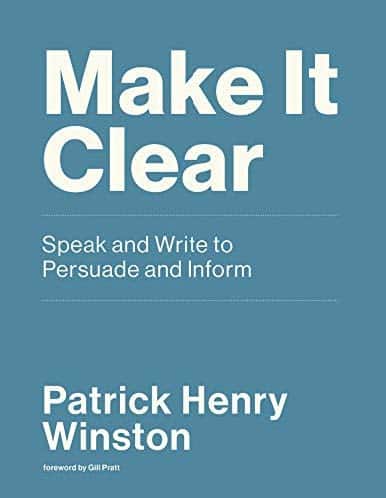Reading and writing are some of the core competencies humans can acquire. Based on them, we start developing and synthesizing knowledge that we later share.
They are also the most difficult to obtain, requiring constant practice. Reading is unnatural, as we started to read “only” about 5000 years ago. Even though reading is an obligatory ability in today’s world of information, writing isn’t.
Writing is a skill that makes some people feel stressed when faced with the necessity. ChatGPT comes to save us all by writing emails and official documents for us, but will it?
In the era of AI-generated content, let’s look at the book that will help us with one of the essential skills closely connected with AI and its history.
Make it Clear was written by Patrick Henry Winston, an American computer scientist, and Massachusetts Institute of Technology (MIT) professor. He served as the director of the MIT Artificial Intelligence Laboratory from 1972 to 1997, where he played a crucial role in fostering AI research and education.

Winston’s contributions to AI encompassed many areas, including natural language understanding, computer vision, and machine learning. One of Winston’s notable achievements was his work on AI-based learning systems, including the development of the Learning Apprentice System (LAP), which aimed to simulate the process of human learning.
We could not think of a better author in modern times to preach the importance of the ability to express oneself clearly and concisely. His dedication to education can be visible on YouTube, where his lecture on public speaking has reached 18 million views. There, he briefly tackles the knowledge that he explains in the book.

“Make it clear,” which, apart from a hefty dose of repetition from lectures available on YouTube, also has a lot of crucial information and curiosities about the written text. We will learn about the brain’s capabilities and thought processes and look at the reader differently.
Fortunately, the reader can learn the basics of computer science or artificial intelligence to understand this book. It can be an excellent gift for journalists and lecturers to acquire this powerful skill.
The book seamlessly blends historical insights into the evolution of artificial intelligence, reflecting Professor Winston’s career, with practical guidance on communication skills. The author intends to equip readers with actionable strategies applicable across various professional contexts.
The strength of “Make it Clear” lies in its relevance and practicality. Readers are not inundated with abstract theories but receive tangible advice tailored to real-world scenarios. Whether preparing for academic presentations or navigating workplace communication, the book offers actionable insights that empower readers to communicate effectively.

The utility of this book extends beyond academia, finding resonance in diverse professional settings. As one reviewer aptly notes, the book is a trusted companion for presentations and writing assignments, fostering continuous improvement in communication skills.
The strength of this title lies in its practicality. It offers straightforward guidance for real-life situations in academia or the workplace. While some critics find it too focused on academia, many readers find its tips helpful.
A handy resource for anyone looking to improve their communication skills. Whether you’re a seasoned professional or just starting, this book offers valuable insights for more transparent communication. When you find yourself with a discharged battery in the middle of nowhere or on the stage in the center of a lecture – your ability to express yourself will be priceless.